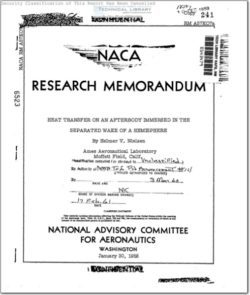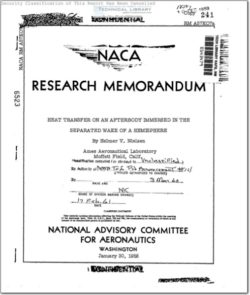NACA-RM-A57k07a

- Version
- 160 Downloads
- 953.73 KB File Size
- 1 File Count
- December 4, 2015 Create Date
- December 4, 2015 Last Updated
National Advisory Committee for Aeronautics, Research Memorandum - Heat Transfer of an Afterbody Immersed in the Separated Wake of a Hemisphere

Tests were conducted to determine the average heat transfer and
temperature recovery factor on a tapered cylindrical afterbody immersed
in the wake of a hemisphere. The range of the investigation was from a
Reynolds number of 125,000 to 870,000 (based on hemisphere diameter and
free-stream conditions). The nominal Mach number was 2.4.
At the lOWer end of the Reynolds number range, the average heat
transfer (as represented by the Stanton number) from the afterbody was
approximately half that from the hemisphere whether the boundary layer
being separated from the rear edge of the hemisphere was turbulent or
transitional. As the Reynolds number was increased, the Stanton number
for both the hemisphere and the afterbody decreased but at a greater
rate for the afterbody. The slope of the afterbody curve indicates that
the heat-transfer coefficient was nearly independent of pressure level
over the range tested.
The temperature recovery factor for the afterbody (based on free-
stream.conditions) was slightly lower than that for the nose whether the
separated.boundary layer was turbulent or transitional. The numerical
values were approximately 0.89 for the nose and from.0.82 to 0.87 for
the afterbody.
As higher and higher Mach numbers-are contemplated the prdblem of
aerodynamic heating assumes increasing importance. Many physical schemes
and geometrical configurations have been proposed to alleviate this prob;
lem. It is the purpose of the present paper to report on a wind—tunnel
investigation of one such device, the use of a separated boundary layer
from the nose section of a body to protect the aftersection.
| File | Action |
|---|---|
| naca-rm-a57k07a.pdf | Download |

Comment On This Post